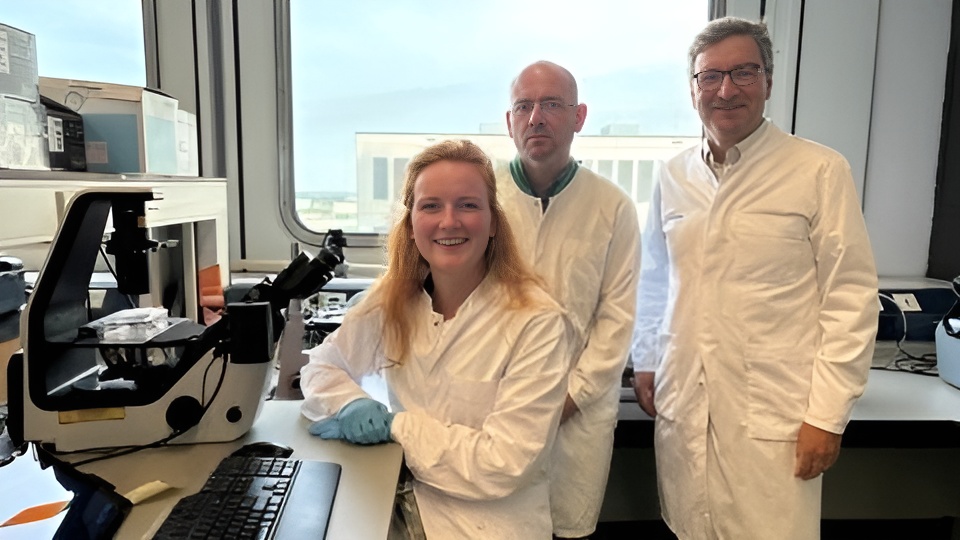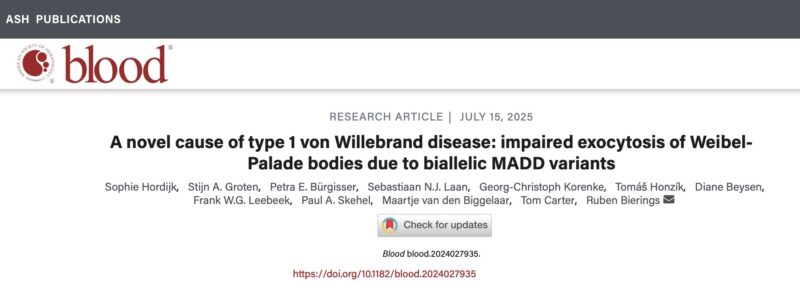
MADD: First Causal Gene for Quantitative Von Willebrand Disease Discovered
Isabel Bär, PhD candidate at Erasmus MC, shared a proud post on LinkedIn:
”Unraveling the cause of a rare disease by studying an even rarer disease… Who says scientists aren’t creative!
So proud of my amazing colleague Sophie Hordijk, under supervision of Ruben Bierings and Frank Leebeek, for investigating the secretion machinery in a disease affecting only 26 patients worldwide and uncovering insights that bring us closer to solving a major mystery in the most common inherited bleeding disorder globally: Von Willebrand disease.
These findings could help explain why around 20% of Von Willebrand disease patients bleed without carrying mutations in their Von Willebrand factor gene. The identification of MADD as the first causal gene for quantitative Von Willebrand disease is a great example of how rare disease research can unlock answers to broader medical questions.
No wonder that Amazing Erasmus MC picked up on it – truly amazing work, congratulations!
If you want to know why it was necessary to go to 4 different countries (Czech Republic, Germany, Belgium, and the UK) to perform this study, check out the interview.
And if you’re looking for a deeper scientific dive beyond this interview, check the recently published results in Blood!”
To learn more, follow the link.
Read the full article here.
Article: A novel cause of type 1 von Willebrand disease: impaired exocytosis of Weibel-Palade bodies due to biallelic MADD variants
Authors: Sophie Hordijk, Stijn A. Groten, Petra E. Bürgisser, Sebastiaan N.J. Laan, Georg-Christoph Korenke, Tomáš Honzík, Diane Beysen, Frank W.G. Leebeek, Paul A. Skehel, Maartje van den Biggelaar, Tom Carter, Ruben Bierings

Stay updated on the latest scientific advancements in the field of bleeding disorders with Hemostasis Today.
-
Jan 7, 2026, 08:50Fahad Khaliq on When is Ticagrelor Preferred Over Other Antiplatelets
-
Jan 7, 2026, 06:41Zain Khalpey on AI Driven Risk Prediction for Optimization of Anticoagulation in LVAD
-
Jan 7, 2026, 05:47Michael Makris: The Wakley Prize Essay Published in Today’s Lancet is an Excellent Read
-
Jan 7, 2026, 05:36Pierre F Sabouret Shares A Study on the Risk of Cardiovascular Death in SIDs
-
Jan 7, 2026, 05:15Glaivy Batsuli Reflects on ASH25
-
Jan 7, 2026, 05:04Heghine Khachatryan on VWD: A Landmark in the History of Hematology
-
Jan 6, 2026, 13:39JAMA Neurology: No Added Benefit of Dual Therapy After Ischemic Stroke in Case of AFib
-
Jan 6, 2026, 10:10This is Fantastic: Shirley D’Sa on Transfusion-Free Christmas Milestone for 𝛃-Thalassaemia Patient at UCLH
-
Jan 6, 2026, 09:53Hamideh Yadegari: Coagulation–Inflammation Crosstalk: Mechanisms, Pathways, and Clinical Implications
